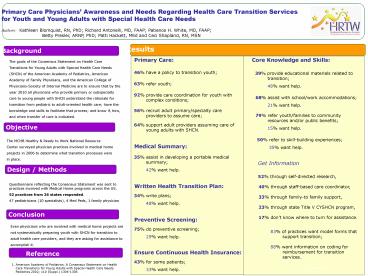Conclusion - PowerPoint PPT Presentation
1 / 1
Title: Conclusion
1
Primary Care Physicians Awareness and Needs
Regarding Health Care Transition Services for
Youth and Young Adults with Special Health Care
NeedsAuthors Kathleen Blomquist, RN, PhD
Richard Antonelli, MD, FAAP Patience H. White,
MD, FAAP Betty
Presler, ARNP, PhD Patti Hackett, MEd and Ceci
Shapland, RN, MSNional Resource Center,
Results
Background
Core Knowledge and Skills
39 provide educational materials related to
transition 48 want
help. 68 assist with school/work
accommodations 21 want help.
79 refer youth/families to community
resources and/or public benefits
15 want help. 50
refer to skill-building experiences
35 want help. Get
Information 52 through
self-directed research, 40 through
staff-based care coordinator, 33
through family-to family support, 23
through state Title V CYSHCN program,
17 dont know where to turn for assistance.
83 of practices want
model forms that support
transition 88 want
information on coding for
reimbursement for transition
services..
Primary Care 46 have a policy to transition
youth 63 refer youth 92 provide care
coordination for youth with complex
conditions 56 recruit adult
primary/specialty care providers to
assume care 64 support adult providers
assuming care of young adults with SHCN.
Medical Summary 35 assist in developing a
portable medical summary 42
want help. Written Health Transition Plan
34 write plans 48 want help.
Preventive Screening 75 do preventive
screening 29 want help. Ensure
Continuous Health Insurance 43 for some
patients 33 want help.
The goals of the Consensus Statement on Health
Care Transitions for Young Adults with Special
Health Care Needs (SHCN) of the American Academy
of Pediatrics, American Academy of Family
Physicians, and the American College of
Physicians-Society of Internal Medicine are to
ensure that by the year 2010 all physicians who
provide primary or subspecialty care to young
people with SHCN understand the rationale for
transition from pediatric to adult-oriented
health care have the knowledge and skills to
facilitate that process and know if, how, and
when transfer of care is indicated.
Objective
The MCHB Healthy Ready to Work National
Resource Center surveyed physician practices
involved in medical home projects in 2006 to
determine what transition processes were in
place.
Conclusions
Design / Methods
Questionnaire reflecting the Consensus Statement
was sent to practices involved with Medical Home
programs across the US. 52 practices from 26
states responded. 47 pediatricians (10
specialists), 4 Med Peds, 1 family physician
Objectives
Conclusion
Even physicians who are involved with medical
home projects are not systematically preparing
youth with SHCN for transition to adult health
care providers, and they are asking for
assistance to accomplish it.
Reference
- American Academy of Pediatrics. A Consensus
Statement on Health Care Transitions for Young
Adults with Special Health Care Needs. Pediatrics
2002 110 (Suppl.) 1304-1306
Printed by































